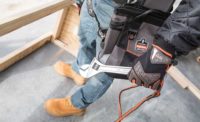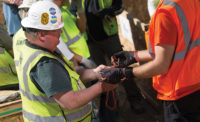Risk solutions for work at heights & dropped objects
Why allow anything to fall?

For decades, leading causes of death on construction sites have been “Falls” and “Struck by Object” according to the Bureau of Labor Statistics (BLS). In 2015, OSHA recorded 364 deaths from falls (38.8 percent of the total construction deaths) and 90 from being struck by objects (9.6 percent of the total construction deaths).
Current regulations
Workers at height in most applications are mandated by OSHA to wear a fall protection harness and be tied off. In the construction industry it’s understood workers must utilize a primary safety system to prevent them from falling, or an active personal fall arrest system (PFAS) to arrest a fall when it occurs. Regarding objects, protection is addressed with debris nets, toe boards and personal protective equipment (PPE) to eliminate or limit potential damage. Here’s how the two risks are addressed:
People are not designed to work at height: People wear a fall protection harness to provide a connection point and keep them at height.
Tools are not designed to be used at height: Tools are allowed to fall with hope that secondary safety measures—hard hats and debris nets—will prevent injury or damage.
The difference between a fall protection program for humans and a fall protection program for objects is only a matter of perspective: one helps save you; the other helps save others.
A known and present danger
When an object falls from height it gathers energy and force. Heavier tools, some up to 80 pounds, can be particularly dangerous. Tools that have pointed attributes, like a nail, screwdriver or spud wrench, can also cause fatal injuries. Even something as light and blunt as a nut fastener has the potential to cause damage, injury or death if it falls from a great enough height.
A three-pound tool falling from 200 feet will travel at a speed of 80 miles per hour when it hits the ground. When this tool finally impacts, hardhats and drop zones are of little consequence.
This damage potential has made news for at least a century. The New York Times published an article on August 2, 1903 about dropped objects, reporting, “with a series of kerchunks extending over the three years during which the new East River bridge has been built, nearly $3,000 worth of tools have fallen from the hands of the workmen into the river.” The equivalent of that financial loss today would be nearly $78,000.
In November 2014, FOX News reported a 58-year-old man died in Jersey City after being struck in the head by a tape measure that fell 50 stories on a job site. This type of incident is more common than people realize. Workers who witnessed the Jersey City incident referenced an ongoing concern of equipment falling from height.
Broader definition of “fall protection”
Historically, “fall protection” referred to preventing people from falling. Now “Fall Protection” refers to anything that can fall, whether it’s a person, debris, tool or piece of equipment. For all objects at height—including humans—it’s not about catching the object (a reactive action), it’s about preventing things from falling (a preventative measure).
All objects—whether people or tools—need protection to help prevent falling. Personal protective equipment manufacturers and regulating bodies such as OSHA, ANSI and ISEA are creating regulations and a product performance standard for dropped object prevention.
In the meantime, OSHA’s General Duty Clause (Section 5(a)(1) requires employers to maintain a workplace “free from recognized hazards that are causing or are likely to cause death or serious physical harm” to employees. OSHA’s criteria for issuing a General Duty Clause Violation include:
- There must be a hazard (such as dropped objects)
- The hazard must be recognized
- The hazard causes or is likely to cause injury or death
- The hazard must be correctable
OSHA requires that if you work in an environment where you’re at risk of being hit by something that falls, you must do the following:
- Secure tools and materials to prevent them from falling on people below
- Barricade hazard areas and post warning signs
- Use toe boards, screens on guardrails or scaffolds to prevent falling objects
- Use debris nets, catch platforms or canopies to catch or deflect falling objects.
A prevention program
The most effective step you can take now is to add a dropped object prevention program for tools and equipment to your existing fall protection program. Identify and evaluate all potential dangers on the worksite. If fall protection is identified as a danger, implement the ABCDEF’s of Fall Protection: Anchors, Body Harness. Connectors, Descent & Rescue, Education and Fall Protection for Tools
First conduct a risk assessment. PPE works best when it compliments all other safety equipment used. An overall risk assessment will help identify all hazards workers must be protected against and the best PPE “package” to deploy.
Fall protection for tools
With all PPE, it’s vital that the activities of each worker be considered. If the PPE constricts or negatively impacts job performance it is less likely to be worn properly, or worn at all. This is especially important to consider when adding PPE to the tools that perform the work.
Tethering tools and equipment with connectors, connection points, and anchors is a common method to prevent tools and equipment from falling. Many tools today have built-in connection points placed by the manufacturer for tethering. Tools and other equipment can be retrofitted with connection points. These tools are then connected to an attachment point via a lanyard.
Depending on the shape, size and use of a tool, it can either be connected to a worker through a tool belt, harness, or wristband (recommended for tools under five pounds), or anchored to a fixed structure (recommended for tools over five pounds). Tools that weigh more than five pounds should never be tied off to a person. If a heavy object becomes uncontrolled, the weight and force could dislocate a wrist or shoulder, or even pull a worker over a ledge or off of scaffolding.
Finally, it’s important to assign and train a competent person to manage the program and equipment.
Looking for a reprint of this article?
From high-res PDFs to custom plaques, order your copy today!





